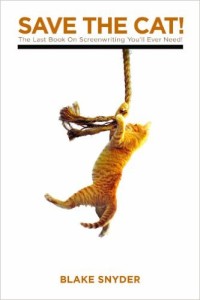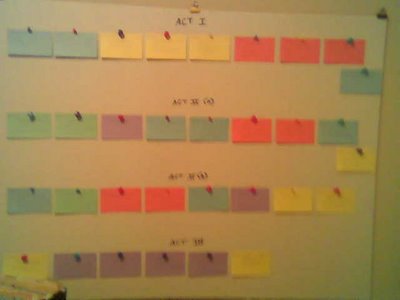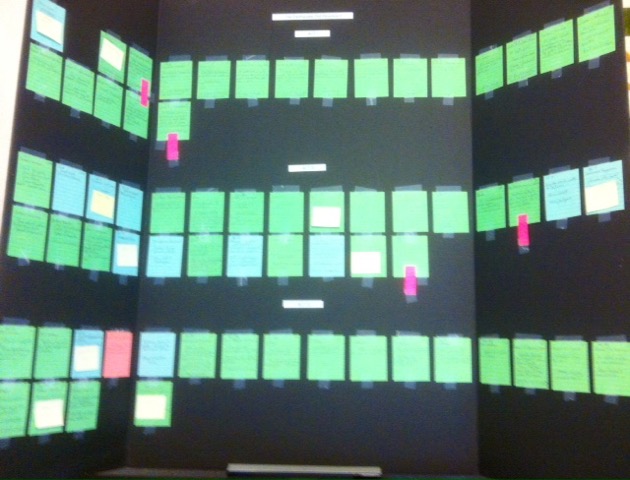 Storyboarding is a plotting technique used by screenwriters, but it’s also popular with some novelists. I like it since I’m a planner, not a pantser. Storyboarding is not a rigid plotting device. The whole point of the board is that it’s flexible. The greatest advantage is seeing exactly how your novel is “built,” just as an architect refers to a blueprint.
Storyboarding is a plotting technique used by screenwriters, but it’s also popular with some novelists. I like it since I’m a planner, not a pantser. Storyboarding is not a rigid plotting device. The whole point of the board is that it’s flexible. The greatest advantage is seeing exactly how your novel is “built,” just as an architect refers to a blueprint.
Now, I realize that some purists eschew structuring their work according to a storyboard. That is fine for those who wish to write Litrachure. But as popular Victorian novelist Wilkie Collins once said, “I have always held the old-fashioned opinion that the primary object of a work of fiction should be to tell a story.” I feel the same way, and I don’t think storyboarding need adversely affect good writing.
I’m indebted to a former mentor who introduced me to the three-act structure most fiction writers are familiar with. She also recommended the late Blake Snyder’s book, Save The Cat! The Last Book on Screenwriting You’ll Ever Need, which opened my eyes to storyboarding. Adapting the screenwriter’s storyboard for film to plotting a novel is easy. The way to use the board is to write the cards and then flesh them out into scenes in a manuscript. I’m so used to this method now that it’s difficult for me to write scenes without having a stack of scene cards in front of me.

To make a board, I use a triptych from the office supply store. I clamp three small binder clips to the top and then hang the board flat on the wall with three small nails. When I’m done with the board, the binder clips can be removed and the board is folded up and stored away, with or without the cards. I’ve found it useful to keep the cards on there as a show-and-tell object for book club presentations. Readers love to see “how you did it.” If you prefer to remove the cards, you can reuse the board for your next book. Here’s The Earthquake Doll storyboard (my Japanese post-war historical), with pushpins removed (so the board can be folded flat) and the cards permanently taped down: Unfortunately, sticky notes don’t work for this because they fall off. I’ve even tried it with the newer, stickier ones. Besides, the notes tend to curl over time. I tried the index card with sticky tops, but those fall off, too. Pushpins rule.
Unfortunately, sticky notes don’t work for this because they fall off. I’ve even tried it with the newer, stickier ones. Besides, the notes tend to curl over time. I tried the index card with sticky tops, but those fall off, too. Pushpins rule.
In Save The Cat!, Snyder calls plot points “beats,” and there are fifteen of them in a story. For more information on that, the Blake Snyder Beat Sheet (BS2) is explained in detail here. By using storyboarding, I could order scenes according to the BS2. Moving a certain scene closer to the beginning of the book meant rearranging my story’s timeline, which in turn messed up all my season-sensitive farming details. All I had to do was change springtime crops to those grown in early autumn in Hokkaido. In fact, it was simple to make any changes needed throughout the book, timeline or plotline, because I could actually see what needed to happen. It was so much easier than scrolling up and down the manuscript on my laptop, and getting hopelessly lost and confused.
In screenwriting, you’d need 40 cards to cover a 110-page script. Your novel could have anywhere from 300-900 or more pages. The main thing is to plan the major plot point scenes. Then write the scene cards leading up to each plot point. Write the cards for the scenes that will come after that, leading up to the next plot point, and so on. On each card, just jot down the basic point of the scene you’re going to write.
You don’t have to write one scene per card. That could take several boards! You could jot related scenes on one card. Or you could group related cards and pin them together. Some people write the cards in Word and print them out. I jot what’s needed in pencil, note the chapter number at the top, and later, the page number of the draft (making ms revisions easy.) Here’s an example of what I wrote on a card for The Earthquake Doll:
(Ch. 14)
Village lane & shrine
[backstory]
Prayers for father
* what would Father think
of her, working for Americans?
The card refers to several scenes: the arrival from the city, the walk down the village lane (with autumnal crops in view) where some backstory is revealed, then to the village shrine where prayers are said for the Main Character’s father. That’s followed by an emotional scene when the MC asks her mother what her father, who fought and died in the war, would have thought of her now, working for an American family.
Is storyboarding for you? Lots of writers use some version of it, whether it’s a detailed formula with a three-act structure like Melissa Pearl, or just a chapter-tracking spreadsheet. What works for you?
P.S. – “Save the cat” is a screenwriting term. Early in the film, our hero, the MC, should do something equivalent to saving a cat to gain our admiration. Here’s to saving cats and storyboarding!

This is cool. Years ago when I wrote and produced television commercials, this was how we explained the process to the client. Now, I use the cards when I am assembling a book. I like the idea of the board, then I would be able to see if all in front of me at once. Everything old (for me) is new again, eh? Thanks
Ah! So you know how to use these things for real! 🙂
I agree it’s a natural for adaptation to novel-writing.
As to everything old becoming new again? Oh yes, ma’am. When bell-bottomed pants came back I didn’t know whether to laugh or cry…
Heavens to Murgatroid! They’re back?
(new to the blog – ** waves to everyone**)
I know many writers use this kind of device but as a pantser it doesn’t work for me. It makes me feel trapped.
It’s definitely not for everyone, and if something makes you feel trapped then it could seriously affect your creativity, and who needs that! But I feel about storyboards the same way I think about recipes: they are suggestions, not commands! As you know, sometimes characters make their wishes known no matter what you thought you were going to do. That’s why I write my cards in pencil. 🙂
Me, too, Yvonne. And I’ve *never* understood the need to rearrange scenes. For one thing, scenes, to me, build each onto the one before it organically, and moving them about would make this impossible.
I love Save the Cat! because of the eight genres thing, but that’s about it.
This is a very thought-provoking article! I’m going to give storyboarding a go for an upcoming novel that’s so complex I need a good visual overview. Proper planning avoids perilous pitfalls!
I’m not so convinced about the BS2 formula though – at least, I think we have to adapt is as fiction writers. There’s a conflict between Blake’s first three beats (Opening Image; Theme Stated; Set-up) and the old maxim ‘Start the story where the story starts’. Particularly in my genre (thrillers), if something doesn’t explode in the first paragraph (broadly speaking), then I’ve started the story too late. The Opening Image *is* the Catalyst (beat 4), and Theme is something that can be exposed gradually or left implicit.
That aside, the principle of storyboarding is highly applicable to the novel format. So thank you for that: a new approach is often a very good way of refreshing ideas as well as working methods!
The BS2 is a bit too detailed for me, too. In the book I’m working on now (a quirky mystery) I made a point of getting the Opening Image, Theme Stated, and Set-Up beats in there just to see if I could. The Catalyst actually occurs between the opener and the theme. So, it’s certainly more flexible than in screenwriting.
You’ll probably enjoy trying the storyboarding technique. I use sticky notes on the cards when there’s a change in the timeline. In your case, with a highly complex story, you might experiment with color-coding your scene cards. That would be a great visual aid.
Thanks for the alliteration, btw. 🙂
Interesting. I’ve never used storyboarding. I’m somewhat of a pantser. I prefer to have an overall sense of where the story is going to end up, but don’t do detailed outlines. I do like the idea of having the visual of the board so you can see easily what else needs fixing if you make a change. If only someone could storyboard for me after I’ve written the first draft, but before I start revisions. 🙂
The main advantage is the visual aspect. It can be a huge help to *see* that a certain chunk of the story would work better in another spot (or even that it isn’t needed at all.) It can also show if there’s a long stretch of b-o-r-i-n-g! 🙂 I really like it for lots of reasons.
I use storyboarding in a very loose way, because I have to be careful about stifling my creativity, such as it is. I tend to free-write a bunch of chapters first, and then create a structure to hold them together. Then I write the rest of the story.
However, Save the Cat is my Bible when it comes to story form. Of course, like the Bible, I don’t interpret it literally, because it is written for film scripts. But a story is a story is a story, and the development of a human emotional experience follows the same pattern, no matter what the medium. Thank you, Candace and Blake.
I’m all for using what works for each individual. If we keep the focus on STORY, we’re doing it right!
Have you ever read Snyder’s “Save The Cat Goes to the Movies”?
I love the idea of laying out the plot visually. I do a similar thing, first on a giant sketchpad, then on the whiteboard mounted to a wall in my writing room. What a cool prop, though, to bring to book clubs!
When I first started with the three-act structure (before Blake Snyder) I plotted it out in pencil on a long roll of brown paper. That worked well, but the cards gave me much more flexibility. Again, whatever works! And yes, it’s a great prop. 🙂
I always work from a synopsis, which divides my proposed book into workable sections. I’m planner as well, but have never tried storyboarding. Thanks for sharing your thoughts and experiences, Candace.
You’re quite welcome, Linda!
The word “synopsis” is a horror to me. I admire your ability to *start* the process with something I avoid doing. Ever. LOL
Storyboarding is actually used by many directors, in conjunction with cinematographers, set designers and editors, to map out the progression of a film. Walt Disney developed the concept in the 1930s, and it subsequently became associated with animation. But it’s also used for TV commercials. Since cinema and television are visual mediums, it’s best to see how each scene will move along. It’s also come into use for educational and instructional purposes. PowerPoint, for example, is basically a storyboarding technique.
Personally I prefer to write down things as they come to me. I feel the characters in my stories are people I meet, and, as time passes, they reveal bits of their lives to me; whereupon the tale unfolds.
On a side note, I visited your web site and like how you describe yourself as a “person of interest.” I often find myself in that same situation. But, when you’re from Texas, I suppose that’s to be expected. 🙂
Another author I know of, Diana Gabaldon, author of the famous “Outlander” books, does it the way you’re talking about. She writes scenes in whatever order they come to her, and somehow stitches it all together later. I admire anyone’s ability to do that.
Hah! Yes, I’m a native Texan and also from the DFW area. In Dallas, especially, a woman can become a person of interest if her shoes and bag don’t match. And my “match,” I mean the leather came from the same cow. Preferably one that Daddy owns. 🙂
Hey, thanks for signing up for the newsletter! I’ll send you the November one that’s already out, and you can expect December’s on the 1st.
I write like that. Scenes all out of order, then they need to be sewn together like Frankenstein. I don’t recommend it!
The trick is that, as the writer, you know exactly where and how all the pieces fit back together. It may take us a while to do it, but we often get it done. I find it challenging, yet exciting. I usually plan things out, but with my writing, I like to be surprised.
Thank you, Candace. I look forward to your newsletters.
This sounds perfect for one of my students. Thank you. I shall also give it a go for my next novel which threatens to be hideously complex time line wise and POV wise.
Great! I hope it works out for your student and for your next novel. Let me know when you can, please!